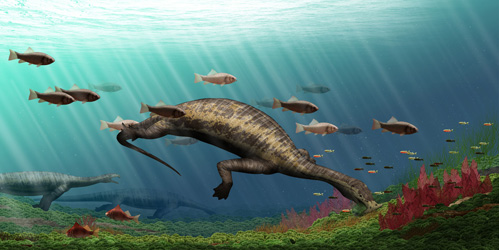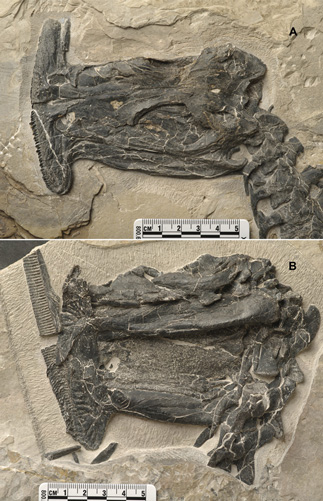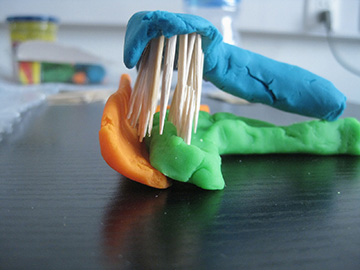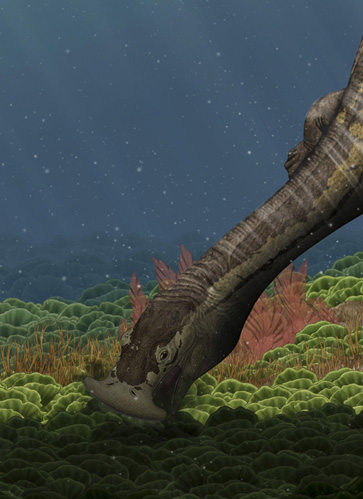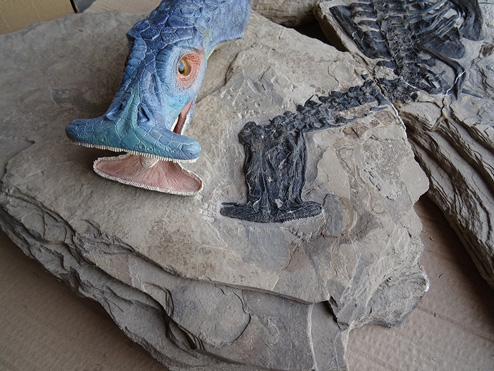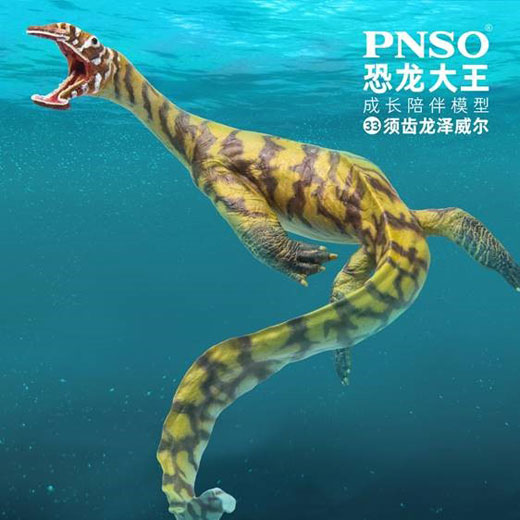Atopodentatus Unzipped According to New Research
Atopodentatus unicus Has a Makeover
In April 2014, Everything Dinosaur reported on the discovery of a bizarre Triassic marine reptile from south-western China called Atopodentatus unicus. The skull and jaws were described as being highly unusual, with nothing like them having been found in the fossil record of marine vertebrates before. The upper jaw was thought to resemble a slit with small teeth forming a fine sieve or comb-like structure. This bizarre creature was assumed to be a specialist carnivore and it was held up as an example of how the marine ecosystems had bounced back and produced strange new animals in the shadow of the End Permian extinction event.
Atopodentatus unicus
It turns out that Atopodentatus may not have been so bizarre after all, however, its existence does help to support the theory that marine food chains did indeed recover remarkably quickly following the mass extinction that marked the end of the Palaeozoic. In a paper published in “Science Advances”, the skull and jaws of this three-metre-long reptile have been re-examined. Atopodentatus was certainly a specialist, but most likely a herbivore with a jaw shaped like a hammerhead used to graze on seaweeds and algae. As such, it is the earliest example of herbivory in marine reptiles, pre-dating the previously earliest known marine animals to have eaten plants by some eight million years.
A New Interpretation of Atopodentatus unicus – A Marine Reptile Herbivore
Picture credit: Y. Chen, Institute of Vertebrate Palaeontology and Palaeoanthropology (IVPP).
“Unzipping” a Marine Reptile
More fossils unearthed in China’s Yunnan Province by scientists from the IVPP allowed researchers to see further examples of the preserved skull and jaws, although flattened and crushed like other fossil material, analysis of the jaw and skull morphology using modelling clay led the scientists to conclude that Atopodentatus did not have “zipper jaws”, but rather a hammerhead structure, which is still a remarkable adaptation.
Close up Images of Fully Prepared Atopodentatus Skull Material
Picture credit: W. Gao, Institute of Vertebrate Palaeontology and Palaeoanthropology (IVPP)
The photograph shows two views of flattened A. unicus skull material (A) a dorsal view, from the top down and (B) a ventral view, viewed from the bottom. The scientists, which included Olivier Rieppel (The Field Museum, Chicago) and Nicholas Fraser (National Museums of Scotland, Edinburgh) as well as Li Chun (IVPP) and Cheng Long (Wuhan Centre of China Geological Survey), have deduced that this marine reptile rasped off algae and plants from rocks and then sucked in the suspended plant remains filtering out the food from the seawater using its needle-like teeth.
A Very Strange Animal
Commenting on the research, Dr Rieppel stated:
“It’s a very strange animal! It’s got a hammerhead, which is unique, it’s the first time we’ve seen a reptile like this. To figure out how the jaw fitted together and how the animal actually fed, we bought children’s clay, kind of like Play-Doh and rebuilt it with toothpicks to represent the teeth. We looked at how the upper and lower jaw locked together and that’s how we proceeded to describe it.”
Modelling Clay Helped Map the Morphology of this Middle Triassic Marine Herbivore
Picture Credit: Dr Rieppel (Field Museum)
Strange Jaws and Teeth
The hammerhead shaped jaws, also described by Everything Dinosaur team members as an “upside down T shape” had peg-like teeth along their edges. Further back into the mouth, Atopodentatus had bunches of needle-like teeth.
How Did Atopodentatus Feed on Plant Material?
Picture credit: Y. Chen (IVPP)
The scientists describe the feeding mechanism of Atopodentatus thus:
The spatulate, peg-like teeth lining the hammerhead were probably used to scrape off plant material such as seaweed and algae from submerged rocks. This would result in large amounts of plant matter being suspended in the water. This was then sucked into the mouth and filtered by the long, thin and closely packed needle-shaped teeth located more posteriorly in the mouth. Not only did the jaws of Atopodentatus resemble a vacuum cleaner attachment, it sucked like a vacuum cleaner too.
Dr Rieppel observed:
“The jaw structure is clearly that of an herbivore. It has similarities to other marine animals that ate plants with a filter-feeding system, but Atopodentatus is older than them by about eight million years.”
A Model of the Redefined Skull of Atopodentatus with Fossil Material for Comparison
Picture credit: Nicholas Fraser (National Museums Scotland)
A Recovering Ecosystem
The evolution of such a bizarre-looking marine reptile, not long after the End Permian extinction event, helps to support the hypothesis that vertebrates bounced back relatively quickly following the mass extinction of much of the back-boned fauna of the Late Permian. However, instead of being placed in food webs representing the eastern Tethys Ocean of the Middle Triassic as carnivore (feeding on zooplankton and crustaceans), the position of Atopodentatus will have to be modified to reflect its diet.
To read the original story describing Atopodentatus: Bizarre New Triassic Marine Reptile Described.
For an article that looks at the food web of the eastern Tethys Ocean during the Triassic: Chinese Sea Dragon Hints at Triassic Marine Fauna Recovery.
A Replica of an Atopodentatus (PNSO Models and Figures)
The picture (above), shows Zewail the Atopodentatus figure that forms part of the extensive PNSO Age of Dinosaurs range. To view this range: PNSO Age of Dinosaurs Figures.
Visit Everything Dinosaur’s user-friendly and award-winning website: Everything Dinosaur.


